SUMMARY HIGHLIGHTS
- Some of the most popular destinations you can visit with the Kansai Area Pass include Kyoto, Osaka, Nara, Kobe, and Himeji Castle.
- You’ll need to visit more distant destinations like Himeji Castle, Hikone Castle, Iga Ueno, or Koka to make the pass pay off.
On a recent trip to Kyoto and Osaka, I purchased a JR West Kansai Wide Area Pass to explore more of the region. It’s a 5-day version of the Kansai Area Pass with wider coverage.
I started in Kyoto and traveled to Amanohashidate. I moved west to Kinosaki Onsen and Tottori before continuing south to Okayama. On the fifth and final day, I explored Takamatsu before circling back to Osaka. By the time I was done, I wound up getting over 2.5 times the value of the pass.
I certainly got my money’s worth, but I did have to move every day and stay at a different hotel every night. I specifically targeted destinations that needed no more than a day to fully explore, so the trip was fun for me, but I do realize it may not be for everyone.
What if you weren’t willing to move around as much? What if you wanted to use Osaka or Kyoto as a base, and take day trips to different parts of the Kansai region? Would the JR West Kansai Area Pass pay off?
Let’s find out.
EXPLORE KANSAI QUICK LINKS
To help plan your trip to the Kansai region, I’ve compiled links to recommended tours, experiences, and other travel-related services here.
JR WEST KANSAI AREA PASS
You can purchase the Kansai Area Pass on Klook.
EXPERIENCES
- Osaka: Learn How to Make Osaka’s Famed Box Sushi
- Kyoto: Fushimi Inari Hidden Hiking Tour
- Nara: Nara Half Day Trip Walking Tour
- Kobe: Private Tour of the Takenaka Carpentry Tools Museum
- Himeji Castle: Half-day Himeji Castle Town Bike Tour
- Lake Biwa: Make Miso & Explore Japan’s Fermentation Culture
OTHER SERVICES
- Travel Insurance (non-US residents get 5% off)
- Japan eSIM
GUIDE TABLE OF CONTENTS
WHAT IS THE JR WEST KANSAI AREA PASS?
The JR West Kansai Area Pass is a rail pass that allows foreign tourists (on “Temporary Visitor” visa status) unlimited travel on JR trains and local JR buses in designated areas within the Kansai region (see map below) for one to four (1-4) consecutive days.
Kansai Area Pass holders can also use the Haruka limited express train to travel between Kansai International Airport (KIX) and Kyoto. No other limited express (or shinkansen) JR trains are covered by the pass.
On top of unlimited travel on JR trains and buses, pass holders will also receive one (1) voucher each for the Kyoto City Subway 1-Day Pass, the Keihan 1-Day Kyoto Sightseeing Pass, and the Hankyu Kyoto Line 1-Day Pass. You can refer to the map below to see the coverage area for these 1-day passes. Vouchers must be exchanged at designated stations before use.
The Kansai Area Pass also entitles bearers to free use of rental bicycles at designated Ekirin Kun outlets within the coverage area.
Listed below are the prices (June 2025) for the JR West Kansai Area Pass. You can purchase all four versions of the pass on Klook. The Kansai Area Pass is a physical ticket, not a digital pass*, so you’ll need to claim it from a major JR station within the covered area before using it.
*The 3-day version of the pass appears to be an exception. On Klook, it’s available in both physical and digital formats.
| 1-Day | JPY 2,800 |
| 2-Day | JPY 4,800 |
| 3-Day | JPY 5,800 |
| 4-Day | JPY 7,000 |
The following maps** show the areas covered by the Kansai Area Pass and the three 1-day passes. Pass holders can travel along these routes as often as they want within the validity period of their pass. Jump to the FAQs section of this guide for more information on the JR West Kansai Area Pass.
**Please note that the maps below are simplified versions to help you visualize available routes. You can visit the JR West website for more detailed maps.
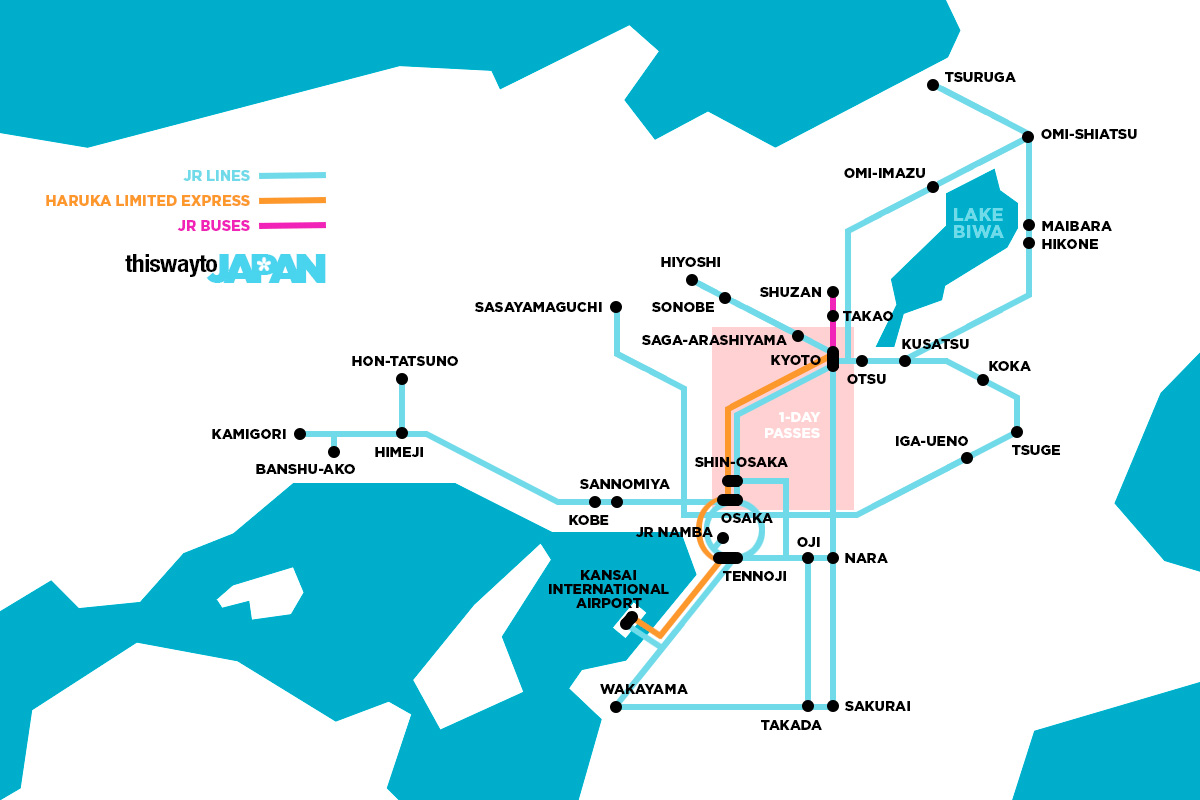
The Kansai Area Pass covers travel on JR trains to parts of Osaka, Kyoto, Nara, Kobe, Himeji, Wakayama, and the areas around Lake Biwa. It covers travel on the Haruka limited express between Kansai International Airport and Kyoto, and entitles pass holders to unlimited use of local JR buses between Kyoto Station, Takao, and Shuzan.
Click here to enlarge the map.
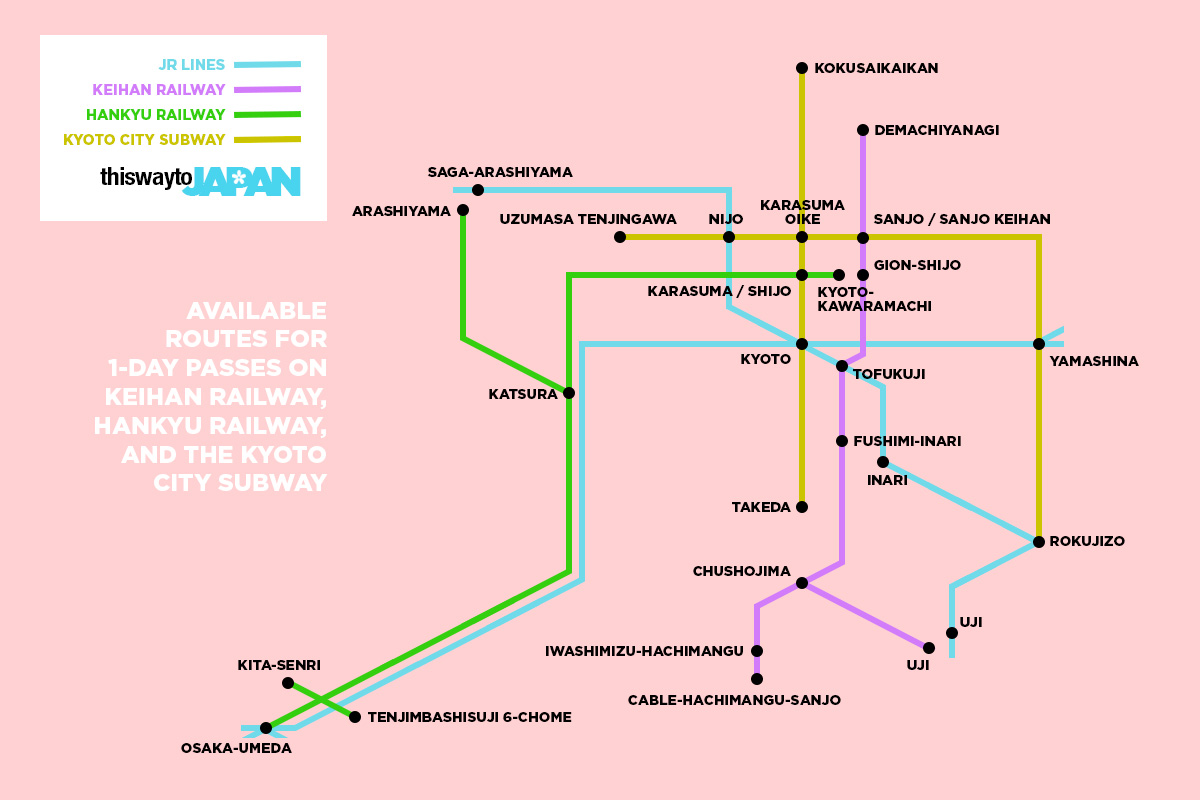
Kansai Area Pass holders will receive one (1) voucher each for the following non-JR 1-day rail passes. Vouchers must be exchanged at designated stations, and each 1-day pass can only be used during the validity period of your Kansai Area Pass.
Keihan 1-Day Kyoto Sightseeing Pass – one calendar day of unlimited use of the Keihan Main Line as indicated above. The voucher must be exchanged at Keihan Sanjo, Tofukuji, or Uji stations.
Hankyu Kyoto Line 1-Day Pass - one calendar day of unlimited use of the Hankyu Kyoto Line as indicated above. The voucher must be exchanged at Hankyu tourist information counters at Osaka-Umeda, Kyoto-Karasuma, or Kyoto-Kawaramachi stations.
Kyoto City Subway 1-Day Pass - one calendar day of unlimited use of the Karasuma and Tozai subway lines as indicated above. The voucher needs to be exchanged at subway station ticket counters or at the Kyoto City Bus & Subway Information Center in front of Kyoto Station.
Click here to enlarge the map.
PLACES TO VISIT WITH THE KANSAI AREA PASS
This isn’t a complete list but highlighted below are some of the most popular destinations you can visit using a JR West Kansai Area Pass.
Osaka
Kansai International Airport is located in Osaka, making it a common entry point into the Kansai region. Known for attractions like Universal Studios Japan and Osaka Castle, it’s one of the most visited cities in Japan – famous for its nightlife, delicious food, and excellent shopping.
Osaka’s central location makes it an ideal base for day trips using your Kansai Area Pass. In my opinion, Namba (pictured below) is the most exciting part of Osaka, but if you plan on taking a day trip everyday, then I suggest staying near Osaka Station to reduce transit times.
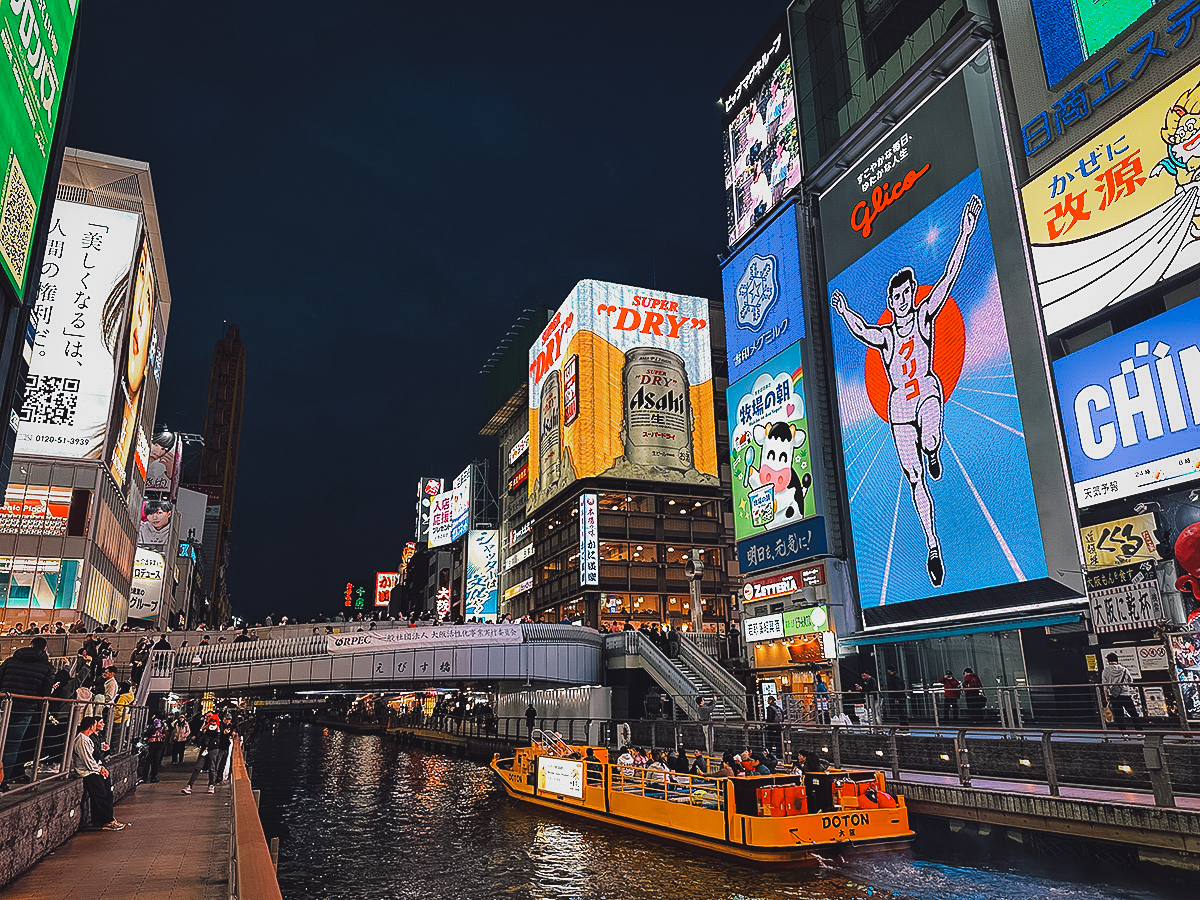
Kyoto
Kyoto needs little introduction. Home to over 2,000 temples and shrines[1], the former capital remains a center for arts and culture in Japan. For those drawn to Japan’s traditional side, there’s truly no better place to immerse yourself than in Kyoto.
With so much to see and experience, Kyoto deserves more than a quick visit. Personally, I think even a week isn’t enough, but if you’re short on time, you can still cover the major highlights in a day or two, especially on a guided tour.
Top attractions include Kiyomizu-dera, Fushimi Inari Taisha, Kinkaku-ji, and Arashiyama Bamboo Grove (pictured below). Keep in mind that Kyoto is at the center of the overtourism problem in Japan, so arriving early at each attraction is essential if you want to avoid heavy crowds.
Like Osaka, Kyoto is a practical base for exploring the Kansai region with your Kansai Area Pass. If that’s your plan, then staying near Kyoto Station is a good idea.
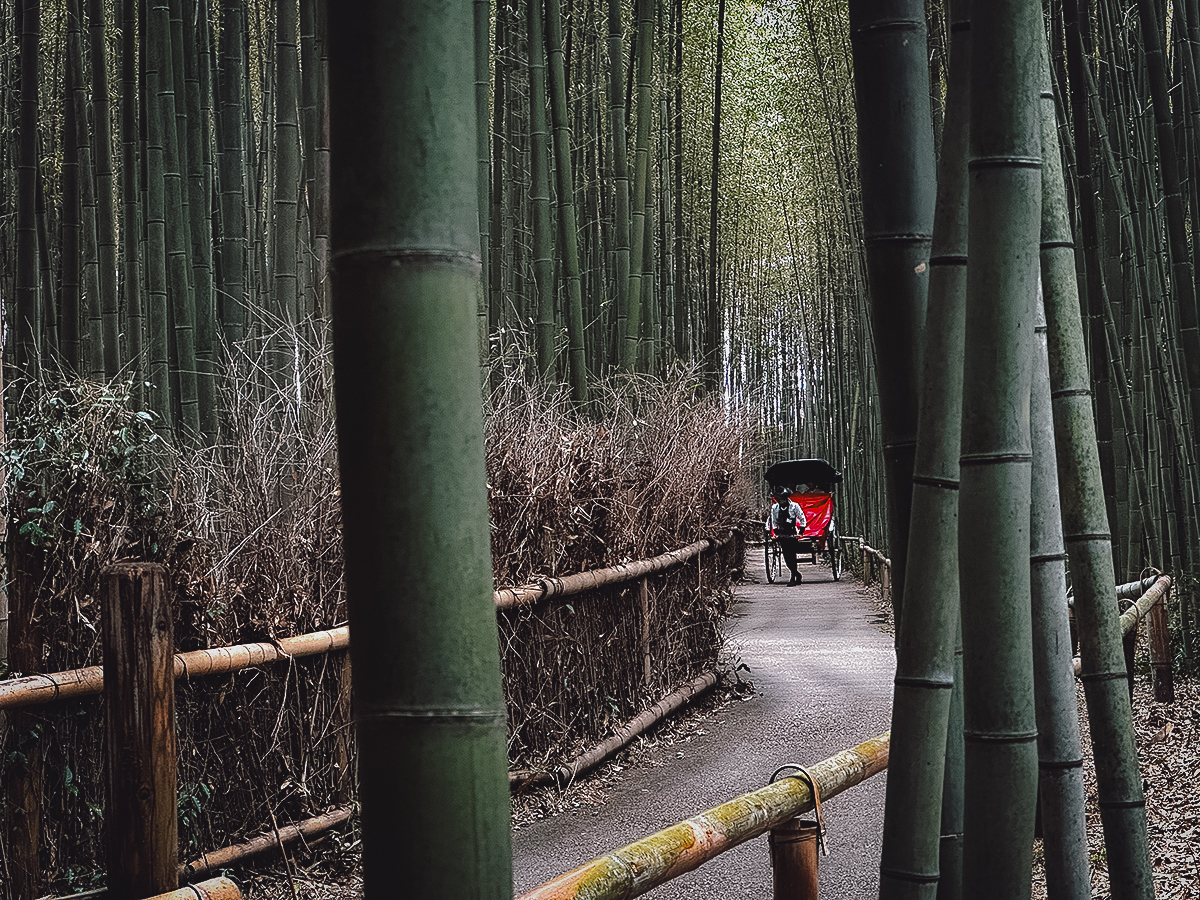
Nara
If you find Kyoto’s temples captivating, then you’ll surely enjoy Nara as well. Home to many temples and shrines, not to mention over a thousand free-roaming sika deer, I like to think of it as “Kyoto-light with deer”.
Like Kyoto, Nara boasts a high concentration of cultural landmarks, most notably the Historic Monuments of Ancient Nara. It’s a group of eight historical sites collectively inscribed as a UNESCO World Heritage Site. Over half of these sites are located in and around Nara Park, which is where the vast majority of visitors spend most of their time in Nara.
It’s easy to explore Nara Park on your own, but you can also join a guided tour. Within its grounds are the Nara National Museum, a pair of beautifully landscaped Japanese gardens, and plenty of deer waiting to be fed with shika senbei crackers. A word of caution – some of the deer can get a little aggressive with food.

Kobe
Of the Kansai region’s major cities – Osaka, Kyoto, Nara, and Kobe – Kobe often flies under the radar. This is both a blessing and a shame. It’s a shame because Kobe is a surprisingly cool city, but it’s also a blessing because it doesn’t get nearly as crowded as its more famous neighbors (at least for now).
I spent a few days in Kobe on a recent trip and found it to be one of the most livable cities I’ve visited thus far in Japan. It’s cosmopolitan yet relaxed, with far more to offer than just Kobe Beef.
Highlights for me included the Takenaka Carpentry Tools Musuem and the Nunobiki Herb Gardens and Ropeway. The area around Kobe Port Tower (pictured below) is perfect for people-watching, while Chinatown is a lively spot to enjoy cheap street food.
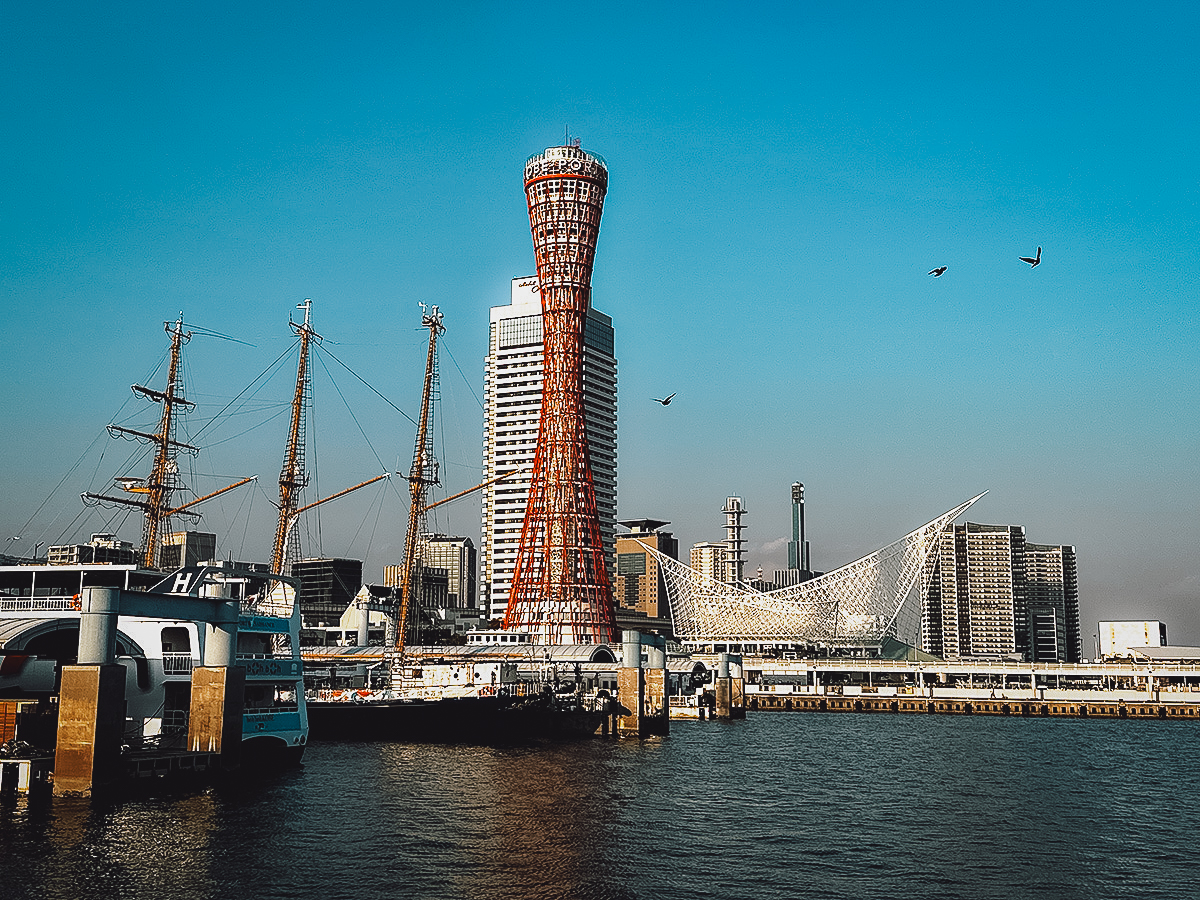
RELATED ARTICLE: Luxury Experiences in Kyoto
Himeji Castle
Of all the castles I’ve visited in Japan, Himeji Castle remains one of the most memorable. Nicknamed the “White Heron Castle” for its elegant white facade, it’s impressive not just for its size, but also for its exceptional state of preservation.
Situated in the city of Himeji, about an hour and a half west of Osaka by train, it’s one of just two sites that were part of Japan’s original list of UNESCO World Heritage Sites[2].
Himeji Castle is also one of just twelve original castles left standing in Japan. Unlike many others that have been rebuilt or heavily restored due to natural disasters or war, Himeji has survived intact and remains largely in its original form.
You can tour the castle independently, but if you prefer a guided experience, then you may want to consider this Himeji bike tour or this private Himeji Castle night tour.
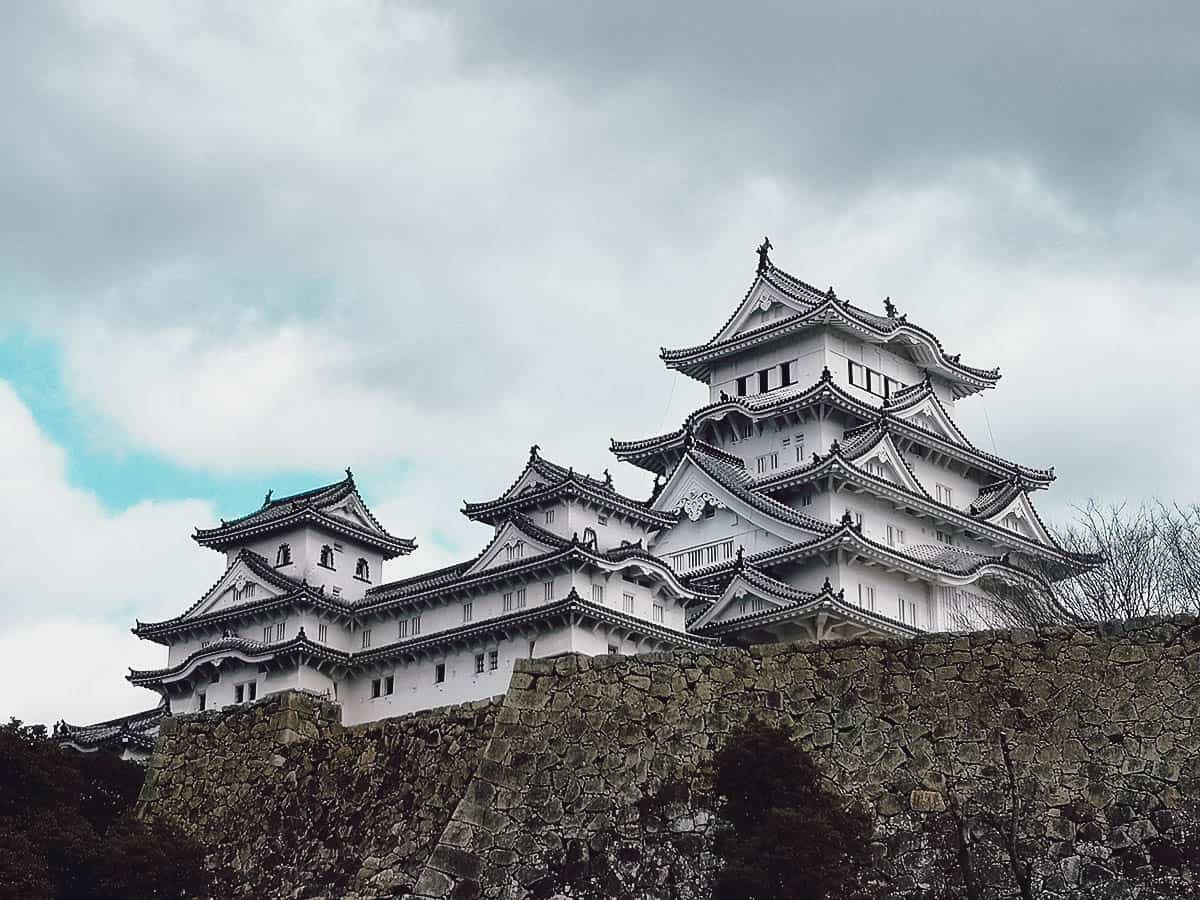
Lake Biwa
Located in Shiga Prefecture, Lake Biwa is Japan’s largest freshwater lake. This lute-shaped lake’s southwestern tip is less than half an hour from Kyoto Station, but with around 235 km (146 miles) of total shoreline, it needs a few days to fully explore[3].
While a few days are ideal to experience everything Lake Biwa has to offer, you can visit some of its key attractions in a day or two. Highlights include Hikone Castle (pictured below), one of Japan’s twelve remaining original castles, and the atmospheric merchant town of Omihachiman. Another interesting stop is the floating hall of Mangetsu-ji Temple.
Perched atop Mt Hiei, Enryaku-ji Temple offers breathtaking views of Lake Biwa and is well worth a visit. Just note that while the Kansai Area Pass covers part of the route, you’ll need to pay separately for the cable car ride to the summit.
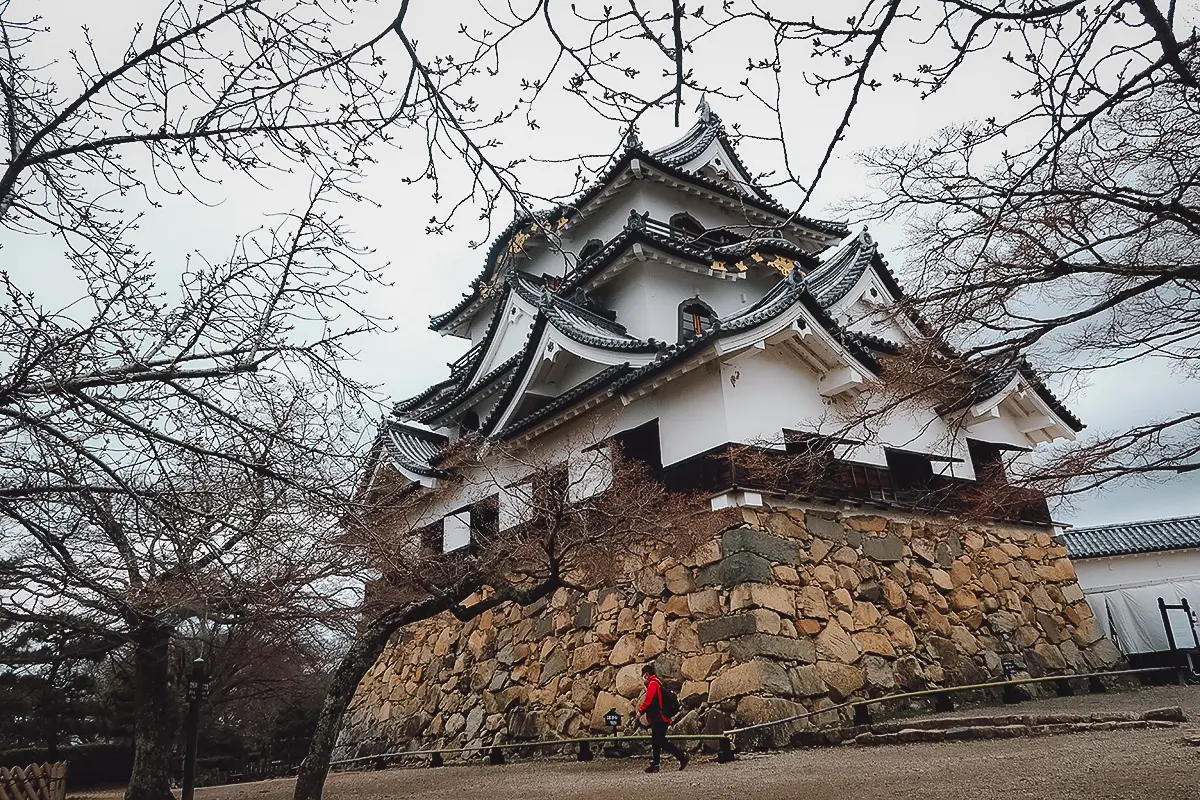
Iga Ueno
Iga Ueno and Koka are known for being the ninja capitals of Japan. Luckily for ninja fans, you can visit both using your Kansai Area Pass.
Once home to one of Japan’s most renowned ninja schools, Iga Ueno in Mie Prefecture celebrates its ninja legacy at the Iga-ryu Ninja Museum (pictured below). This small but fascinating museum features ninja-themed exhibits (with English translations), a traditional ninja house, live ninja shows, and hands-on experiences with real ninja weapons like shuriken, blow darts, and throwing knives.
Though the museum is the main draw, there’s more to explore at Iga Ueno, most notably Iga Ueno Castle and the memorial and museum dedicated to Matsuo Basho, one of Japan’s most celebrated haiku poets.
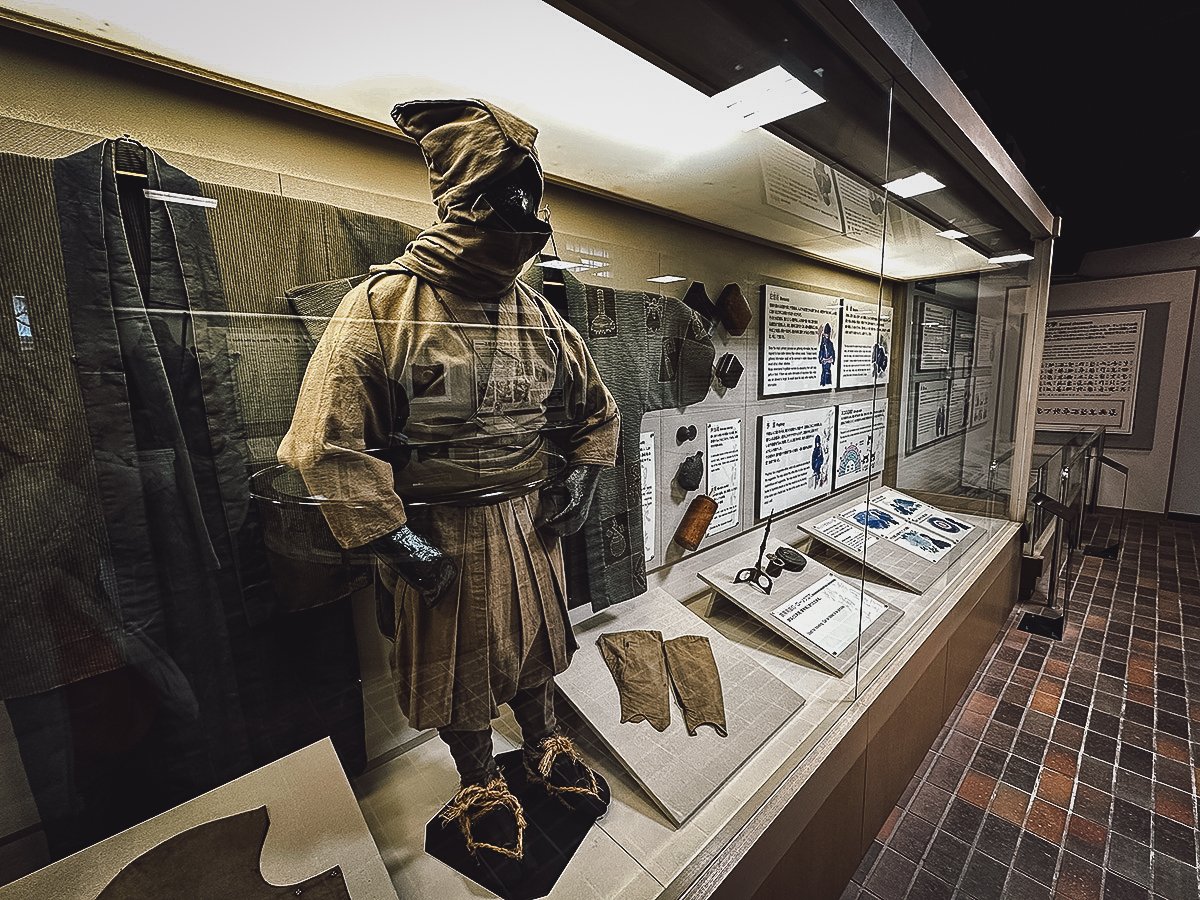
Koka
Like Iga Ueno, Koka is famous for its ninja heritage. Compared to its neighbor, there doesn’t seem to be as much to see and do in Koka, but this small town in Shiga Prefecture does boast what I found to be the best ninja attraction in either city.
Koka-ryu Ninjutsu Yashiki is a ninja house and museum that served as the former residence of the leading Mochizuki ninja clan. Unlike the ninja house attraction in Iga Ueno, Koka-ryu Ninjutsu Yashiki is a real ninja house that was used and lived in by an actual ninja family.
Not only are the video exhibits highly informative, but you can go through parts of the house too. Pictured below is the crawl space hidden on the second floor. Like the ninja museum in Iga Ueno, you can throw ninja stars here as well.
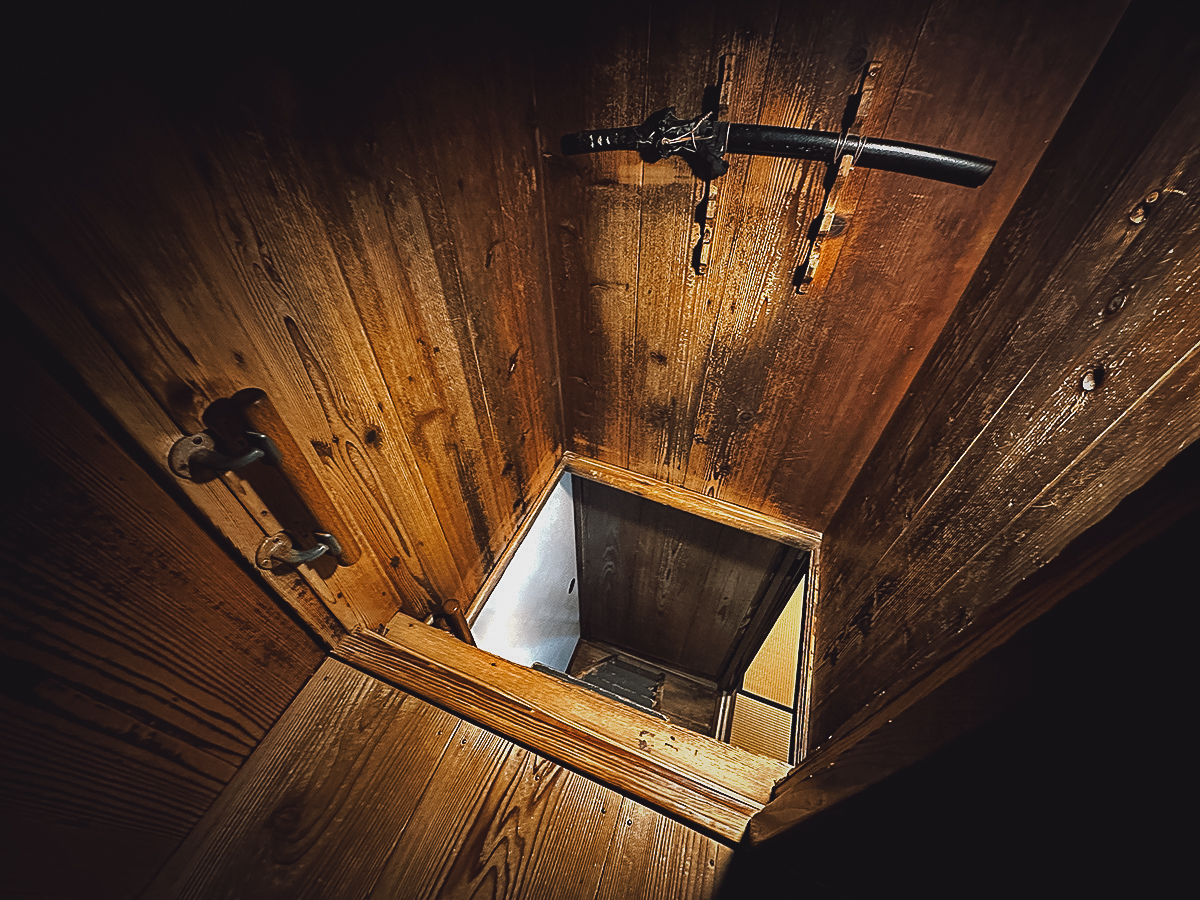
KANSAI AREA PASS FAQs
How long is the pass valid for?
The Kansai Area Pass is valid for one to four (1-4) consecutive calendar days – not 24-hour periods. So even if you begin using it at 11:30 PM on May 1st, May 1st will still count as your first full day.
How do I use the pass?
The Kansai Area Pass is a physical card, about the size of a credit card. To use, just insert it into the ticket gate at the station. Don’t forget to grab it from the exit slot before walking through!
Is the pass transferrable?
No, the pass is for individual use only. It’s available exclusively to non-Japanese passport holders with “Temporary Visitor” visa status. You’re advised to carry your passport with you for verification when using it.
Is it worth getting the Kansai Wide Area Pass over the Kansai Area Pass?
Obviously, it depends on how long you’re traveling for and where you want to go. The Kansai Wide Area Pass takes you as far as Amanohashidate, Kinosaki Onsen, Tottori, Okayama, Takamatsu, and the Kumano region. If you’re interested in exploring those destinations, then yes, it can save you a lot of money.
Personally, I saved JPY 18,170 on transportation with the Kansai Wide Area Pass.
Do I need to reserve seats on the Haruka limited express?
You can, but you don’t have to. You can ride using non-reserved seats as often as you like, but you’re entitled to a maximum of two (2) seat reservations on the Haruka limited express. You can make reservations at a green ticket-vending machine or a station ticket office.
Where can I get more information?
If you need more information about the Kansai Area Pass, then you can visit the JR West website.
IS THE JR WEST KANSAI AREA PASS WORTH IT?
Like any rail pass in Japan, it depends on how often you use it. You can plot your trips on Google Maps to determine if the pass will be worth it in your case.
Let’s break it down per version, assuming you’re using Osaka as a base and taking day trips.
1-Day
The 1-day pass costs JPY 2,800. Even if you use it to explore both Kyoto and Nara on the same day, it’ll be difficult for the pass to pay for itself.
You’ll need to make a day trip to a more distant destination like Himeji Castle, Hikone Castle, Iga Ueno, or Koka to make it pay off.
2-Day
The 2-day pass costs JPY 4,800. If you use it to make day trips to two of the more distant destinations, then the pass will pay off.
If you use one day of the pass to visit a more distant destination, and the second day to explore Kyoto, Nara, or Kobe, then the pass can still pay for itself, but you may have to take a few JR trains within the city to do it.
3-Day
The 3-day pass costs JPY 5,800 and is a better value than the 2-day version. Using one day to visit a more distant destination and using the other two days to explore Kyoto, Nara, or Kobe can make the pass pay off.
4-Day
The 4-day pass costs JPY 7,000. Like the 3-day version, it’s easier to make it pay off. As long as you visit one of the more distant destinations and use the other three days to explore Kyoto, Nara, and Kobe, then the pass should pay for itself.
Disclosure
Some of the links in this article on the Kansai Area Pass are affiliate links, meaning we’ll get a small commission if you make a purchase at no added cost to you. We only recommend products and services that we use ourselves and firmly believe in. We really appreciate your support as this helps us make more of these free travel guides. Arigato gozaimasu!
References
1. Kyoto’s Temples and Shrines. My Kyoto Machiya. (2015, March 15).
2. Japan’s World Heritage Sites. japan-guide.com.
3. Lake Biwa. The Gate to Kansai. (2024, June 18).
